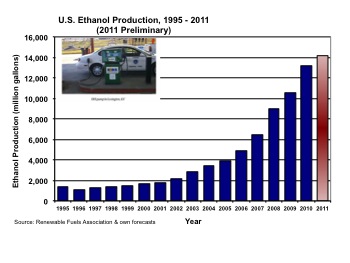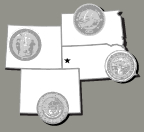Implications of the Ethanol Industry for Cow-Calf Producers
by Troy Smith for Angus Productions Inc.

“A $1-per-bushel increase in the price of corn results in about a 15% to 20% increase in hay price,” explained K-State's Ted Schroeder. “For the cow-calf producer, that means the annual cost of maintaining a cow increases by about $15.”MITCHELL, Neb. (Nov. 29, 2011) — Speaking before the Range Beef Cow Symposium XXII in Mitchell, Neb., Kansas State University (K-State) ag economist Ted Schroeder said he came neither as proponent nor opponent of the ethanol industry. As an observer, however, he said he believes the long-term result of demand-driven ethanol production from corn is a smaller, restructured beef industry that receives higher prices for beef and cattle.
According to Schroeder, there is no doubt that expanded ethanol production has resulted in increased costs and reduced revenue for cow-calf producers — in the short run. With competition for supplies, the price of corn has increased. Forage prices increased, too, as more acres are allocated to growing corn.
“A $1-per-bushel increase in the price of corn results in about a 15% to 20% increase in hay price,” explained Schroeder. “For the cow-calf producer, that means the annual cost of maintaining a cow increases by about $15.”
 The cost of raising replacement heifers also increases with higher grain and forage prices. In addition, prices received for feeder calves decline because there is reduced demand by feedlots faced with higher costs of gain. Schroeder said that same $1 increase in corn price, and associated increase in hay price, means feeder buyers will likely pay $60 per head less for a 750-pound steer.
The cost of raising replacement heifers also increases with higher grain and forage prices. In addition, prices received for feeder calves decline because there is reduced demand by feedlots faced with higher costs of gain. Schroeder said that same $1 increase in corn price, and associated increase in hay price, means feeder buyers will likely pay $60 per head less for a 750-pound steer.
According to Schroeder, the long-term adjustment to reduced profitability is a contraction of the nation’s cow herd. The least profitable producers are likely to exit the industry, and the remaining more-profitable producers are likely to become larger. Their profitability may then increase when, because of fewer overall cattle numbers, demand drives prices for cattle and beef higher.
Asked what can be done to alter the course of events, Schroeder said challenging government policy supporting ethanol production (import tariffs, blenders’ credits and renewable fuel mandates) probably wouldn’t make much difference.
“I wouldn’t expect much success. Instead, I advise investment in technology and management strategies that improve beef production efficiency that helps offset higher costs," said Schroeder. “But I’d hang most of my hope on expanding global demand for U.S. beef.”
Growing consumer markets for beef can increase industry revenue by taking advantage of North America’s comparative advantage for producing high-quality beef. Growing demand for the product, said Schroeder, is an effective way to offset increased production costs.
The biennial Range Beef Cow Symposium was hosted Nov. 29-Dec. 1 at the Mitchell Events Center, Mitchell, Neb., by the cooperative extension and animal science departments of the University of Nebraska-Lincoln, South Dakota State University, Colorado State University and the University of Wyoming. Comprehensive coverage of the event is provided online at www.rangebeefcow.com, an event coverage site provided by Angus Productions Inc. (API), publisher of the Angus Journal and the Angus Beef Bulletin.
Editor’s Note: API's coverage of the event is made available for distribution to all media via an agreement with the Range Beef Cow Symposium Committee and API. Headquartered in Saint Joseph, Mo., API publishes the Angus Journal, the Angus Beef Bulletin, the Angus Beef Bulletin EXTRA, and the Angus e-List, as well as providing online coverage of events and topics pertinent to cattlemen through the API Virtual Library. For questions about this site, or to notifiy us of broken links, click here.

